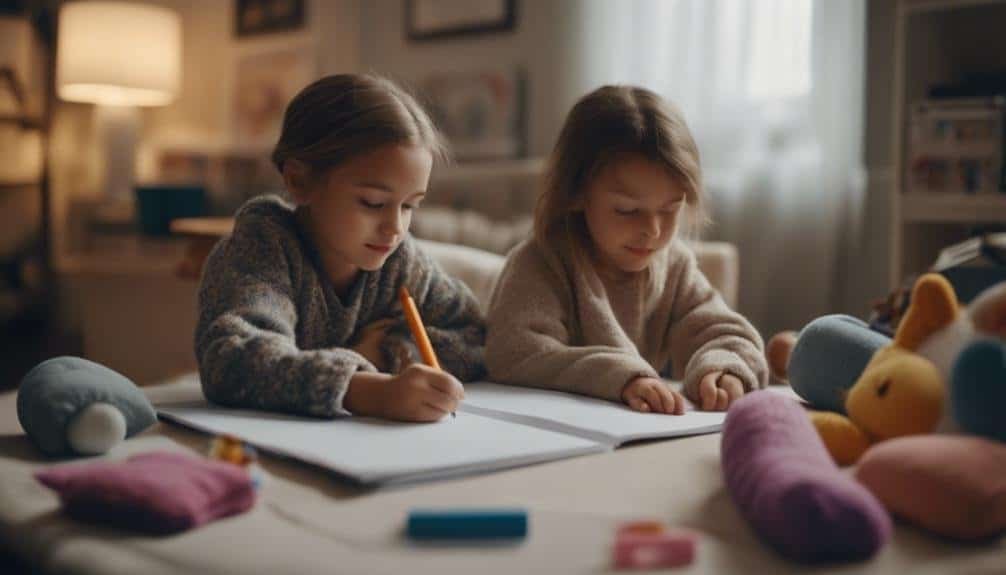Therapy for Childhood Trauma
When addressing childhood trauma, therapy can be like a compass guiding you through uncharted waters. The journey towards healing from early adverse experiences can be complex and challenging, but the benefits of therapy are profound.
Understanding the various therapeutic approaches and the importance of professional guidance is essential in sailing this path. As you sail the delicate process of addressing emotional triggers and building trust, remember that there are innovative methods, such as expressive arts, that can aid in your recovery.
Opening the door to therapy opens the possibility of long-term resilience and healing.
Key Takeaways
- Therapy provides essential tools for healing and breaking free from trauma cycles.
- Coping strategies and emotional regulation techniques help manage past experiences' impact.
- Establishing trust, safety, and boundaries in therapy is crucial for a secure healing environment.
- Self-care practices and expressive arts aid in emotional healing and trauma processing.
Benefits of Therapy for Childhood Trauma
If you have experienced childhood trauma, therapy can provide you with essential tools to commence on a healing journey towards a healthier, more fulfilling life. Setting off on a healing journey through therapy allows you to confront past experiences, process emotions, and develop coping mechanisms. Through therapy, you can work on resilience building, which is vital in overcoming the impact of childhood trauma.
Therapists trained in trauma-focused approaches can guide you in understanding how your past experiences have shaped your present beliefs and behaviors. By addressing these underlying issues, therapy empowers you to break free from the cycle of trauma and develop healthier patterns of thinking and relating to others. Additionally, therapy can help you build resilience by enhancing your ability to adapt to challenges, bounce back from setbacks, and cultivate a sense of inner strength.
Types of Therapeutic Approaches
Several therapeutic approaches are available to address childhood trauma, each with its unique focus and methods tailored to help individuals navigate their healing journey. Therapeutic modalities play a vital role in assisting individuals in processing traumatic experiences and fostering resilience.
Cognitive Behavioral Therapy (CBT) is a widely used approach that helps individuals identify and reframe negative thought patterns related to their trauma, promoting healthier coping mechanisms. Eye Movement Desensitization and Reprocessing (EMDR) is another effective modality that utilizes bilateral stimulation to help individuals process traumatic memories and reduce distress.
Play therapy is particularly beneficial for children, allowing them to express and make sense of their experiences through play activities in a safe environment. Additionally, Dialectical Behavior Therapy (DBT) equips individuals with mindfulness skills and emotional regulation techniques to manage the impact of trauma on their lives.
These various therapeutic approaches offer diverse tools and strategies for trauma processing, empowering individuals to work through their past experiences and move towards healing and recovery.
Importance of Professional Guidance
Exploring through childhood trauma can be complex, which is why seeking professional guidance is key to facilitating your healing journey effectively. The self-discovery journey towards healing can be overwhelming, but with the right support, you can navigate through it successfully. Here's why professional guidance is essential:
- Emotional Validation: Trained therapists provide a safe space for you to express your emotions without judgment, helping you feel heard and understood.
- Expertise in Trauma: Professionals have specialized knowledge and skills to address childhood trauma effectively, guiding you through the healing process with evidence-based techniques.
- Personalized Support: Working with a therapist offers personalized care tailored to your unique needs, ensuring that you receive the specific guidance required for your healing journey.
Addressing Emotional Triggers
Exploring through emotional triggers can be a challenging yet important aspect of healing from childhood trauma. Identifying triggers that bring up intense emotions is the first step towards understanding how past experiences continue to impact your present well-being. These triggers can vary from specific situations, places, smells, or even certain phrases. By recognizing these triggers, you empower yourself to manage emotions effectively and navigate them in a healthier way.
In the healing process, emotional regulation plays a critical role. Learning to regulate your emotions means developing the ability to understand, tolerate, and express your feelings in a constructive manner. This skill not only helps in managing triggers but also enhances your overall emotional well-being. Techniques such as mindfulness, deep breathing, and grounding exercises can aid in regulating emotions when faced with triggers.
Building Trust and Safety
How can you cultivate a sense of trust and safety as you commence on your journey of healing from childhood trauma? Establishing boundaries and fostering connections are essential steps in creating a safe space for your healing process.
- Establishing Boundaries: Setting clear boundaries is vital in creating a sense of safety during therapy. Learning to say no, identifying your limits, and communicating your needs help establish a secure environment where you feel respected and understood.
- Fostering Connection: Building a trusting relationship with your therapist is key to the healing journey. Through open communication, empathy, and mutual respect, you can develop a strong connection that provides the support and safety needed to address past traumas.
- Creating a Safe Environment: Surrounding yourself with supportive and understanding individuals can also contribute to a sense of safety. Whether it's friends, family, or support groups, having a network of people who respect your boundaries and offer a listening ear can enhance your healing process.
Coping Strategies for Survivors
When dealing with the aftermath of childhood trauma, it's imperative to equip yourself with effective coping strategies. Grounding techniques can help manage flashbacks, while building a reliable support system can provide a sense of safety and understanding.
Engaging in self-care practices is vital for your healing journey and overall well-being.
Grounding Techniques for Flashbacks
During moments of distressing flashbacks, grounding techniques can serve as important tools for survivors of childhood trauma to anchor themselves in the present and regulate overwhelming emotions.
Here are some helpful strategies:
- Grounding Exercises: Engage in activities that involve the senses, such as feeling the texture of an object or focusing on your breath.
- Mindfulness Techniques: Practice staying present in the moment without judgment, acknowledging thoughts and feelings as they arise.
- Visualization: Picture a safe space or a comforting memory to help shift your focus away from the flashback.
These techniques can assist in bringing you back to the current moment and reducing the intensity of the flashback, providing a sense of control and safety.
Building a Support System
To sail the healing journey from childhood trauma, establishing a robust support system is fundamental for survivors as they cultivate coping strategies for resilience and growth.
Peer counseling and group therapy provide safe spaces for sharing experiences and receiving validation from others who understand.
Engaging with community resources can offer access to professional help, financial assistance, and other forms of support tailored to your needs.
Online forums create opportunities to connect with individuals facing similar challenges, fostering a sense of belonging and reducing feelings of isolation.
Building a support system not only provides emotional support but also practical assistance in sailing the complexities of healing from childhood trauma.
Self-Care Practices for Healing
Wondering how you can practice self-care to aid in your healing journey from childhood trauma? Prioritizing your well-being as you navigate through this challenging process is crucial. Here are some effective self-care practices to ponder:
- Mindful Meditation: Engage in mindful meditation to help ground yourself in the present moment, reduce anxiety, and promote emotional healing.
- Nature Therapy: Spend time outdoors in nature to benefit from its calming and rejuvenating effects on your mental health.
- Self-Compassion: Practice self-compassion by treating yourself with kindness and understanding, acknowledging your pain, and validating your emotions.
Healing Through Expressive Arts
Engaging in expressive arts can be a powerful and transformative way to heal from childhood trauma. Art therapy, a form of expressive arts, allows you to communicate and express emotions that may be difficult to verbalize. Through painting, drawing, or sculpting, you can externalize your internal struggles and gain insights into your feelings and experiences. This process can lead to a release of pent-up emotions, providing a sense of relief and catharsis.
Additionally, expressive arts promote mind-body integration, helping you reconnect with your body and sensations that might've been numbed or disconnected due to trauma. Engaging in activities like dance, music, or drama can foster a sense of embodiment and grounding, allowing you to feel more present in the moment. Research has shown that these practices can reduce stress, anxiety, and symptoms of trauma by promoting relaxation and self-awareness.
Incorporating expressive arts into your healing journey can offer a creative outlet for processing and transforming past experiences, ultimately supporting your emotional well-being and growth.
Trauma-Informed Care Practices
As you explore trauma-informed care practices, remember the importance of comprehending how trauma affects individuals differently.
Establishing trust-based relationships is key in supporting those who've experienced childhood trauma.
Creating a safe and secure environment promotes healing and growth for those managing the effects of past traumatic experiences.
Understanding Trauma Effects
Understanding the impact of trauma is essential in providing effective and empathetic care for individuals who've experienced traumatic events. When delving into trauma effects, it's vital to grasp the following key points:
- Trauma Rewiring: Traumatic experiences can rewire the brain, affecting thoughts, emotions, and behaviors.
- Healing Stages: Recognizing the different stages of healing can help tailor interventions to the individual's needs.
- Impact on Relationships: Trauma can influence how individuals form and maintain relationships, requiring a sensitive approach to rebuilding trust.
Building Trust Relationships
Moving from understanding trauma effects, it's essential to establish trust relationships as a fundamental aspect of trauma-informed care practices. Trust building forms the cornerstone of therapy for childhood trauma.
Creating a safe space where you feel heard, respected, and understood is important. Therapists work to build trust by demonstrating empathy, consistency, and honesty. It's important to set healthy boundaries to guarantee a secure environment for your healing journey. Boundaries help establish clear expectations and promote a sense of safety within the therapeutic relationship.
As you navigate the process of therapy, remember that trust is a gradual process that unfolds over time. By fostering trust and respecting boundaries, you lay a solid foundation for your healing and growth.
Promoting Safety Environment
Creating a safe and nurturing environment is fundamental in trauma-informed care practices to promote healing and growth for individuals who've experienced childhood trauma. When addressing childhood trauma, creating safe and comforting spaces is essential. Techniques for relaxation and mindfulness play an important role in promoting a sense of safety and security.
Here are some strategies to think about:
- Implement sensory-friendly elements in the environment
- Offer trauma-informed yoga or meditation sessions
- Provide opportunities for grounding exercises
Creating a Supportive Environment
Establishing a nurturing and secure environment is essential in supporting individuals who've experienced childhood trauma. Trauma-informed parenting plays a vital role in creating safe spaces for healing and growth. By understanding the impact of trauma on a child's development, caregivers can provide the necessary support and structure to help them feel safe and secure. Childhood resilience is fostered through consistent and loving interactions, where children are encouraged to express their emotions and build trust in their caregivers.
Creating a supportive environment also involves building healing connections with trusted individuals such as therapists, teachers, or extended family members. These connections serve as a source of stability and comfort for children who've experienced trauma, helping them navigate their emotions and experiences in a healthy way. By surrounding the child with caring and understanding individuals, a strong support system is established, promoting healing and resilience in the face of adversity.
Long-Term Recovery and Resilience
In the journey towards long-term recovery and resilience after childhood trauma, consistent support and validation are key factors in fostering healing and growth. Healing from childhood trauma is a complex process that requires patience and understanding.
Here are some important points to ponder on this path to recovery:
- Resilience Building: Through therapy and support, you can learn to cultivate resilience, the ability to bounce back from adversity and grow stronger through challenges.
- Emotional Regulation: Developing skills to manage overwhelming emotions is vital in finding your way through the ups and downs of the healing journey.
- Trauma Processing: Working through past experiences in a safe and supportive environment is essential for processing trauma and moving towards inner healing.
Frequently Asked Questions
How Can Therapy for Childhood Trauma Impact Relationships With Family Members and Loved Ones?
When therapy helps you heal from childhood trauma, it can positively impact trust and relationships with loved ones. By addressing past wounds, understanding emotions, and improving communication, you can foster healthier connections and build stronger bonds.
Are There Any Potential Risks or Side Effects Associated With Therapy for Childhood Trauma?
As you explore potential concerns about therapy, remember that long-term effects vary. Stay informed, ask questions, and discuss any worries with your therapist. With understanding and collaboration, you can navigate this journey effectively.
How Can Therapy for Childhood Trauma Affect Academic Performance and Social Interactions?
When you engage in therapy for childhood trauma, it can positively impact your academic success by equipping you with coping strategies. Similarly, it can enhance your social skills and emotional regulation, fostering healthier interactions with others.
Is It Possible for Therapy to Retraumatize Individuals Who Have Experienced Childhood Trauma?
It's important to take into account the potential risks when exploring therapy options, especially for those with childhood trauma. Ensuring therapeutic boundaries, understanding trauma triggers, and verifying therapist credibility are essential for emotional safety and healing.
How Can Individuals Access Affordable or Low-Cost Therapy Options for Childhood Trauma?
To access affordable or low-cost therapy for childhood trauma, start by seeking community health clinics, non-profit organizations, or university training programs. Additionally, consider coping strategies, support groups, self-care, and mindfulness practices for holistic healing and recovery.
Conclusion
To summarize, therapy for childhood trauma can be a transformative journey towards healing and resilience. By addressing emotional triggers, building trust, and utilizing expressive arts, individuals can navigate their trauma in a safe and supportive environment.
With the guidance of professionals and trauma-informed care practices, the process of long-term recovery becomes possible. Remember, the impact of therapy is like a ray of sunlight breaking through dark clouds, illuminating the path towards healing and growth.







